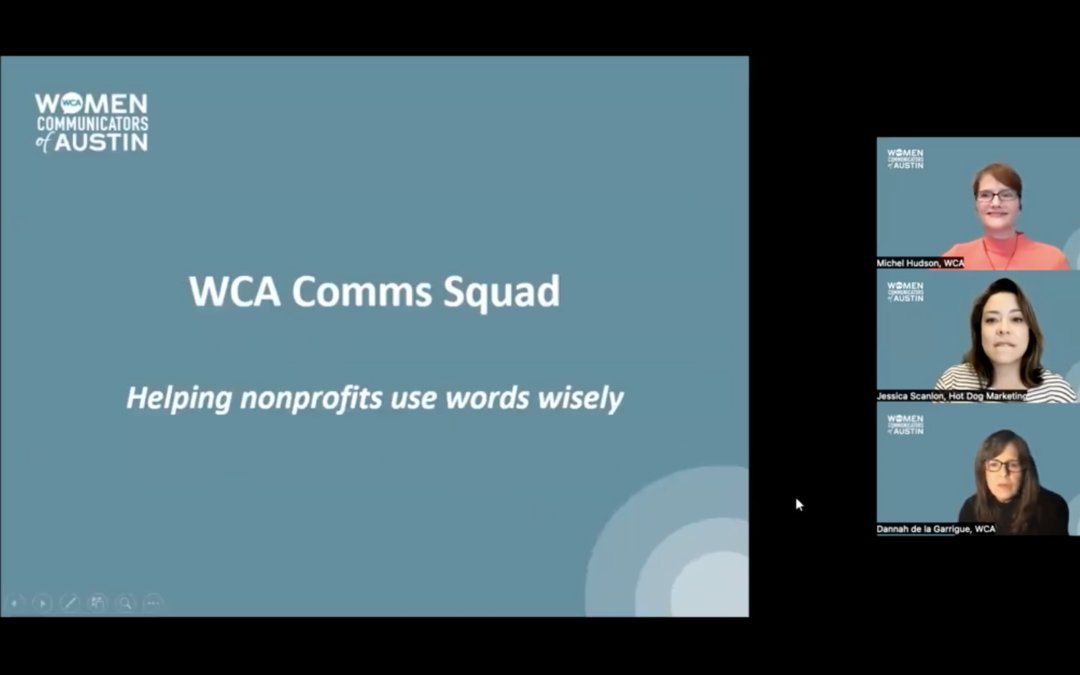In an ideal world, every nonprofit would have a dedicated team of professionals focused on implementing a detailed communications plan that raises the visibility of the organization, attracts donors, and improves community engagement. But in reality, most nonprofits run on a shoestring budget with minimal staff and limited resources. Creating and implementing a strategic communications plan can be a daunting task in the face of the everyday challenges of running a nonprofit.
Women Communicators of Austin (WCA) is here to help organizations take the first steps toward tackling their communications challenges. We are launching the WCA Comms Squad webinar series where we provide education and advice that nonprofits and small communications organizations can use in developing their communications plans. In each episode of our webinar series, we will talk with communications and marketing experts about how to tackle the most challenging aspects of building and implementing an effective communications plan.
Our first episode features Jessica Scanlon, founder of Hot Dog Marketing, an award-winning Round Rock-based firm that the Austin Business Journal ranks as a top woman- and minority-owned business. Jessica has helped more than 350 businesses and nonprofits develop their brands and online reputations. Most recently, she served as president of the board for Texas Humane Heroes, an organization dedicated to rescuing dogs and cats from overcrowded shelters and finding them loving adoptive homes.
Jessica shared some marketing advice and lessons she learned serving with nonprofits.
Establish clear, realistic goals
It’s important to begin with clear communications goals. These goals should be realistic, achievable, time-oriented, and aligned with the overall objectives of the organization. Most of all, they should be intentional—don’t try to do everything all at once and hope something sticks. Instead, start small, focusing on a primary goal and build from there. Understand that in the nonprofit world, most programs will be limited by the size, maturity, and resources of the organization. Learning how to make the most of the resources available will be your greatest challenge.
Now that you’ve established your goals, what are the next steps?
Four pillars of a communications plan
Jessica recommends organizing your communications plan around four central pillars: Educate, Nurture, Thank and Grow. Depending on the size of your organization, you may want to focus on just one or two of the pillars and progress to the others as you grow.
- Educate – This is your opportunity to build a following for your organization. Focus on networking activities and brand awareness. Get out into the community to introduce yourself, make connections and start building a contact list.
- Nurture – Now that you have a following, it’s time to engage with your contacts. The goal is to encourage them to become involved and engaged with the organization. It’s important to have a strategy for staying in touch, whether it’s emails, phone calls or direct mail. The size of your list will help you determine the best method of reaching your audience. Regardless of the method, consistency and quality are key.
- Thank – Showing your appreciation is the best way to keep volunteers, donors, sponsors, and others involved and engaged. It takes seven to 10 touches in different ways to stay top-of-mind. Most importantly, the message needs to be personal and genuine gratitude. Cards, emails, phone calls are all good ways to reach out and say thank you.
- Grow – Once you have established the foundation of your plan through educating, nurturing and thanking your supporters, you can focus on expanding your communications outreach efforts. Grow your network of donors through special events such as fundraisers, capital campaigns, and other community activities. Look at those in your network who are already involved. Who has the capacity to give more time, talent, or treasure? A more personal approach will get better results.
Establishing a communications plan for a nonprofit doesn’t need to be complicated. Take it one small step at a time. Watch for our next webinar about creating brand recognition for your organization.
- The 8 Pillars of Public Relations for Nonprofit Organizations - February 10, 2024
- Helping Nonprofits Find and Differentiate Their Brand Voice - February 1, 2024
- Comms Squad Webinar: Four Pillars of Creating a Communications Plan - October 13, 2022

